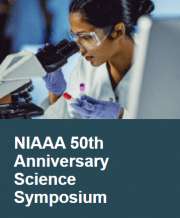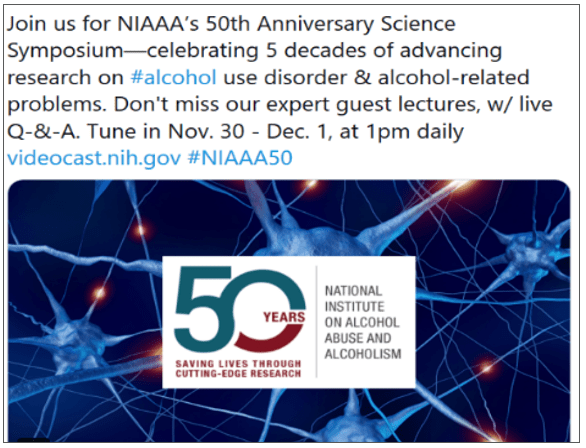NIAAA Director's Report on Institute Activities to the 156th Meeting of the National Advisory Council on Alcohol Abuse and Alcoholism
Virtual Meeting
Table of Contents
- IN MEMORIAM
- NIAAA BUDGET
- NIAAA DIRECTOR'S ACTIVITIES
- STAFF TRANSITIONS
- RECENTLY ISSUED FUNDING OPPORTUNITYANNOUNCEMENTS
- NOTABLE NIAAA STAFF ACTIVITIES
- WHAT'S AHEAD?
- NI RESEARCH HIGHLIGHTS
- NIAAA COMMUNICATIONS AND PUBLIC LIAISON ACTIVITIES
IN MEMORIAM

Kathleen (Kathy) Carroll, Ph.D., passed away in December 2020. Dr. Carroll was a clinical scientist in the Yale Department of Psychiatry who made seminal contributions to improving treatments for addiction. Throughout her career, she promoted broader recognition of the efficacy, safety, and durability of behavioral therapies. She helped establish the Stage Model of Behavioral Therapies Development that facilitated important advances by defining stages of science for behavioral therapies development. Her work also led to the development of an effective web-based version of cognitive behavioral therapy ("CBT4CBT"), one of the first evidence-based computerized interventions for a range of substance use disorders. NIAAA extends our deepest sympathies to her family, friends, and colleagues.

Samuel W. French, M.D., passed away in December 2020. Dr. French was an exceptional pathologist, educator, and researcher for more than half a century. He most recently held positions as Distinguished Professor of Pathology at the University of California, Los Angeles and researcher at the Lundquist Institute for Biomedical Innovation. His prolific and original research, particularly on alcohol-associated liver disease (ALD), was first funded by NIH in 1960 and has resulted in over 500 publications. His seminal contributions to the study of hypoxia, nutrition, and Mallory-Denk bodies in ALD were recognized by high honors, including the 2017 Lifetime Achievement Award from the Research Society on Alcoholism and the Gold Headed Cane Award from American Society for Investigative Pathology.

Linda P. Spear, Ph.D., passed away in October 2020. Dr. Spear, Distinguished Professor Emerita of Psychology at Binghamton University, amassed an extraordinary record of scientific accomplishment and leadership in alcohol research over a long and prolific career. Her studies of the behavioral effects of alcohol in adolescents and the effects of alcohol exposure on the developing brain have been foundational to advances in that area and have continued to the present day with her work as one of the founding members and leaders of the ongoing Neurobiology of Adolescent Drinking in Adulthood (NADIA) Consortium. Dr. Spear served as a member of the NIAAA Advisory Council from 2008 to 2012, and as a member of the NIAAA Extramural Advisory Board from 2004 to 2012. Her excellence in alcohol research was recognized by numerous awards, including the NIAAA Mark Keller Award and the 2018 Lifetime Achievement Award from the Research Society on Alcoholism. The NIAAA community mourns the passing of our friend and colleague
NIAAA BUDGET
Fiscal Year (FY) 2020
NIAAA closed FY 20 on September 30; the final appropriation for NIAAA was $545.4 million. This represented a $19.8 million or 3.8 percent increase over the FY 19 budget level. The NIAAA appropriation includes $6.5 million set aside for the Brain Research through Advancing Innovative Neurotechnologies® (BRAIN) Initiative. A summary of key funding actions within this appropriation are as follows:
- NIAAA awarded 750 research project grants (RPGs), including 161 competing awards
- NIAAA funded 21 research centers for $31.7 million
- NIAAA funded 182 other research grants for $48.1 million
- NIAAA supported 323 full-time training positions for $15.5 million
- NIAAA funding for our Research and Development (R&D) contract portfolio was $34.1 million
- NIAAA support for Intramural research totaled $56.5 million
FY 21
On December 27, 2020, the President signed the H.R. 133 - Consolidated Appropriations Act, 2021. The National Institutes of Health (NIH) received a total of $42.9 billion, $1.25 billion above the fiscal year 2020 enacted level. This funding also includes coronavirus supplemental appropriations, including $1.25 billion for NIH. Additionally, this funding includes allocations for the HEAL Initiative, the 21st Century Cures Act, BRAIN Initiative, and research on influenza. The bill provides a general increase to NIH Institutes and Centers (ICs), and it continues to support the Gabriella Miller Kids First Act pediatric research initiative.
The FY 21 appropriation for NIAAA provides $554.9 million. This represents a $9.55 million or 1.8 percent increase over the FY 20 budget level. NIAAA estimates, at this time, it will support a total of 736 RPGs in FY 21.
FY22
The preparation of the FY 22 President’s Budget is underway.
NIAAA DIRECTOR’S ACTIVITIES
NIAAA Director Dr. George F. Koob gave the following virtual presentations between August 1, 2020, and December 31, 2020:
- “How Alcohol Misuse Fans the Pandemic and the Pandemic Exacerbates Alcohol Misuse” for the Friends of NIAAA Webinar on September 15, 2020
- “NIAAA update – COVID-19 and Diversity Challenges” for the American Psychiatric Association Addiction Council Virtual Meeting on September 18, 2020
- Opening Remarks for the Multi-disciplinary Approach to Advance Care and Outcomes in Patients with Alcohol-associated Liver Disease (ALD) and Alcohol Use Disorder (AUD) Virtual Meeting on October 6, 2020
- “Neurobiology of Addiction: The Gain in the Brain is in the Pain” for the Vanderbilt University Medical Center Discover Lecture series on November 5, 2020
- “Drug Addiction: The Gain in the Brain is in the Pain” as the Distinguished Scientist Lecture for the University of Pittsburgh 2020-2021 Department of Psychiatry Lecture Series on November 6, 2020
- “NIAAA Update” for the Alcohol and Immunology Research Interest Group (AIRIG) virtual meeting on November 20, 2020
- “Celebrating 50 Years of Alcohol Research: Advances, Challenges, and Priorities” at the NIAAA 50th Anniversary Science Symposium on November 30, 2020
- “Alcohol Use Disorder in the time of COVID-19: Challenges for AA” for the Mini-International Conference of Secular AA on December 5, 2020
- “NIAAA Update: COVID-19 and Alcohol Research” and “NIAAA Update: Racial Disparities” for the American College on Neuropsychopharmacology Q&A Forum with NIH Institutes on December 8, 2020
- “Brief Overview of the Dynorphin-Kappa Opioid System” for Trans-NIH Dynorphin/Kappa Opioid Receptor Efforts at NIH on December 14, 2020
- “NIAAA Update” for the NIAAA Liaison Virtual Meeting on December 16, 2020
STAFF TRANSITIONS
New Staff

Dr. Sukru Demiral joined the Division of Intramural Clinical and Biological Research Laboratory of Neuroimaging. Dr. Demiral will use brain imaging (PET, MRI and simultaneous PET/MRI) to study the neurocircuitry that underlies the rewarding effects of drugs of abuse and of natural reinforcers and their disruption in substance use disorders and obesity. Since receiving his Ph.D., he has worked in prestigious scientific research environments including Washington University School of Medicine in St. Louis, The University of Edinburgh, Max Planck Institute, and Carnegie Mellon University.

Dr. Paule Valery Joseph joined NIAAA as a Tenure Track Investigator and Chief of the Section of Sensory Science and Metabolism with a joint appointment at the National Institute of Nursing Research (NINR). Dr. Joseph was previously a Postdoctoral Fellow and Assistant Clinical Investigator with NINR. She was selected as a Lasker Scholar in 2019 and NIH Distinguished Scholar in 2018. Dr. Joseph is a Certified Registered Nurse Practitioner and she earned her Ph.D. in Nursing with a focus on Genomics and Chemosensation from the University of Pennsylvania. Dr. Joseph’s research focuses on the relationship between hedonic pathways, sensory systems, and disease. She is interested in the interplay between metabolic disorders, sensory-related pathways, and brain diseases – particularly alcohol and substance use disorders. This includes individual and addiction-induced differences in thresholds and responses to olfactory and gustatory cues. In addition, following reports of taste and smell loss among individuals affected by COVID-19, Dr. Joseph began investigating chemosensation.

Dr. Shailesh Kumar joined the Division of Neuroscience and Behavior (DNB) in December 2020 as a Health Scientist Administrator (Program Officer). Dr. Kumar comes to DNB from the Systems Biology Center (SBC) at the National Heart, Lung, and Blood Institute, where he was a Staff Scientist for the past 6 years. In SBC, Dr. Kumar’s research provided insights into the mechanisms, cellular functions, and genetic networks underlying sleep and circadian rhythms. In addition, his experience in scientific administration, laboratory management, training, and supervising scientific staff make him a great addition to DNB. Dr. Kumar’s portfolio within DNB will be in the area of animal and human sleep research.

Dr. Yiming Shen joined the Division of Intramural Clinical and Biological Research as a postdoctoral fellow in the Section on Neural Circuits. Dr. Shen obtained his Ph.D. from Seoul National University in 2019. For his thesis project, he examined whether alterations in synaptic plasticity in the hypothalamus helped promote the beneficial effects of exercise training in a rodent model of heart failure.
Internal Transitions
Megan Ryan joined the NIAAA Office of the Director (OD) in September 2020 as a Senior Health Scientific Policy Analyst. Ms. Ryan comes to OD after 14 years as a Clinical Trials Specialist in the NIAAA Division of Medications Development (DMD) and, previously, the Division of Treatment and Recovery Research (DTRR). During this time, she provided leadership as both the NIAAA Small Business Innovation Research (SBIR) and Small Business Technology Transfer (STTR) Program Director and the Technology Development Coordinator. She will continue both roles in her new position.
Dr. Mariela Shirley joined the Division of Treatment and Recovery (DTR) in August 2020. She previously served as a Project Officer in the NIAAA Division of Epidemiology and Prevention Research (DEPR). Dr. Shirley serves as Co-Chair of the NIAAA Centers and Training Working Group. Dr. Shirley earned a Ph.D. in clinical psychology from Vanderbilt University. She is a fellow of the Society of Addiction Psychology (Division 50) of the American Psychological Association (APA), and in 2012 received the APA Meritorious Research Service Commendation Award. Her research expertise areas include screening and behavioral interventions, underage/college drinking, psychiatric comorbidity, and behavioral medicine. In DTR, she oversees a research portfolio that includes alcohol use disorder in youth and older populations, translational research, innovative technologies, and comorbidity.
Dr. Bethany Stangl transitioned to the role of Staff Scientist in the Laboratory on Human Psychopharmacology. She first joined the lab in 2010 as a Postodoctoral Research Fellow after which she became a Research Fellow in 2015 and a Research Scientist after the completion of her fellowship. Since her arrival in the laboratory, Dr. Stangl has led the development and implementation of the intravenous alcohol self-administration paradigm that has become a standard in the field of human behavioral pharmacology research in alcohol. This paradigm enables the evaluation of alcohol seeking and consumption in humans in a controlled laboratory setting. Dr. Stangl has conducted more than 200 infusion sessions and leveraged the data from these studies to examine critical determinants of alcohol seeking and consumption behavior including drinking history, expectancies, impulsivity, impaired control, early life stress, and social influences.
Departing Staff
Deilia (Dee) Beard, Information Technology (IT) Specialist, retired in August 2020 after 20 years of service at NIAAA. Ms. Beard provided IT support at Fishers Lane for many years, including management of desktop computers, software, scientific equipment, network and server services, and account administration. She reviewed and made recommendations for IT equipment and software needs, managed the REES system for environmental monitoring for the facility at Fishers Lane, and provided poster printing services for the Division of Intramural Clinical and Biological Research.
Isabel Ellis, Public Health Analyst, retired after 40 years of federal service in the Department of Health and Human Services (HHS). The first 13 years of her career were spent at the National Institutes of Health (NIH), followed by 7 years in the Office of the Secretary, HHS. Over the last 20 years at NIAAA, she has served in a variety of roles, including project officer for the development of NIAAA’s web-based social work curriculum on the intervention, treatment, and prevention of alcohol use disorder. She also provided review and guidance on Certificates of Confidentiality to NIAAA grantees and other investigators seeking to protect the privacy of research participants.
Thelma Fulton, former Extramural Support Assistant in the Extramural Project Review Branch within the Office of Extramural Activities, has recently taken a position as an Administrative Officer with the Federal Emergency Management Agency (FEMA).
Dr. Klaus Gawrisch, Chief of the Laboratory of Membrane Biochemistry and Biophysics, retired in September 2020. Dr. Gawrisch is an internationally recognized expert in structural biology and the role of lipids in membrane protein function and in the cellular actions of alcohol. His research contributed to understanding the effects of omega fatty acids on membrane properties and the structure and function of G-protein coupled receptors (GPCRs). Among the GPCRs, he focused on rhodopsin and cannabinoid type 2 receptors. Dr. Gawrisch’s laboratory used nuclear magnetic resonance (NMR) techniques to examine lipid and protein structures and structural changes. He pioneered innovative techniques for solid-state NMR, and magic-angle spinning proton NMR.
Dr. Aya Matsui completed her postdoctoral training as a Research Fellow with Dr. Veronica Alvarez in the Laboratory of Neurobiology of Compulsive Behaviors, where she studied neuronal modulation following exposure to cocaine and alcohol. Dr. Matsui joined the Gouaux laboratory at Oregon Health & Science University in 2020 to study the structure and function of synaptic receptors.
RECENTLY ISSUED NOTICE OF FUNDING OPPORTUNITIES
Notice of Funding Opportunities (NOFOs) Issued by NIAAA:
Integrative Neuroscience Initiative on Alcoholism (INIA) Consortia (U24 Administrative Resource – Clinical Trial Optional; U24 Research Resource – Clinical Trial Optional; U01 Research Project – Clinical Trial Optional): INIA is a translational, multidisciplinary, collaborative research effort studying brain mechanisms of excessive alcohol drinking associated with alcohol use disorder (AUD). The research focus includes mechanisms behind changes in the brain that result from excessive alcohol use and are associated with the development of AUD, brain changes that result in excessive use that is then correlated with AUD, and also the relationship between excessive drinking, stress, and anxiety. The primary goal of INIA is to identify brain adaptations at multiple levels of analysis that result in excessive alcohol consumption. RFA-AA-20-011; RFA-AA-20-012; RFA-AA-20-013
Improving Health Disparities in Alcohol Health Services (R01 – Clinical Trial Optional): This NOFO solicits applications on health disparities and health services-related research focusing on: 1) access to treatment; 2) making treatment more appealing; 3) costs; 4) dissemination and implementation. All applications are expected to emphasize health disparities in addition to the other four areas of focus mentioned above. RFA-AA-21-001
NIAAA Resource-Related Research Projects (R24 – Clinical Trial Not Allowed): The purpose of the Resource-Related Research Projects (R24) grant is to support investigator-initiated resources designed to provide materials and services to support and advance biomedical research on a national basis. An R24 resource grant mechanism is a non-hypothesis-driven activity to provide data, materials, tools, or services that are essential to making timely, high quality, and cost-efficient progress in a field. PAR-21-072
Prevention and Intervention Approaches for Fetal Alcohol Spectrum Disorders (R34 – Clinical Trial Optional): This NOFO for R34 planning grant applications focuses on prevention and intervention strategies for fetal alcohol spectrum disorders (FASD) throughout the lifespan. The intent of this NOFO is to support research that advances (1) prevention approaches to reduce prenatal alcohol exposure and incidence of FASD and (2) interventions for FASD. PAR-21-097
Prevention and Intervention Approaches for Fetal Alcohol Spectrum Disorders (R61/R33 – Clinical Trial Optional): The intent of this NOFO is to support research that advances (1) prevention approaches to reduce prenatal alcohol exposure and the incidence of FASD and (2) interventions for FASD. These objectives will be accomplished with the Exploratory/Developmental Phased Award (R61/R33) mechanism, clinical trial optional. The R61 phase will support pilot studies or secondary data analysis for hypothesis development and feasibility, and research testing the hypotheses can be expanded in the R33 phase. PAR-21-098
Notices of Special Interest (NOSIs) Issued by NIAAA:
Advances in Research for the Treatment, Services, and Recovery of Alcohol Use Disorder: The purpose of this NOSI is to advance research on various topics that fall within NIAAA’s Division of Treatment and Recovery Research (DTRR). DTRR’s research interests are wide-ranging and encompass broad categories such as health services, behavioral therapies and mechanisms of behavior change (MOBC), recovery, translational research, and innovative methods and technologies for alcohol use disorder (AUD) treatment and sustaining recovery. Other areas of interest include topics focusing on special-emphasis and underserved populations, including NIH-designated U.S. health disparity populations, as well as those with co-occurring disorders; and fetal alcohol spectrum disorders (FASD). In all studies, at all levels from FASD to elderly, efforts will be made to include participants that reflect the diversity of the population at large. NOT-AA-20-022
Alcohol-induced Tissue-specific and Organ System Diseases: The purpose of this Notice is to inform potential applicants of NIAAA’s special interest in research project applications studying the harmful effects of alcohol on the body’s tissues, organs, and systems in diverse populations across the lifespan. NOT-AA-20-024
NIH-Wide NOFOs and NOSIs with NIAAA Participation:
BRAIN Initiative: Pilot resources for brain cell type-specific access and manipulation across vertebrate species (U01 – Clinical Trial Not Allowed) RFA-MH-20-556
BRAIN Initiative Cell Census Network (BICCN) Scalable Technologies and Tools for Brain Cell Census (R01 – Clinical Trial Not Allowed) RFA-MH-21-140
BRAIN Initiative: New Concepts and Early-Stage Research for Recording and Modulation in the Nervous System (R21 – Clinical Trial Not Allowed) RFA-EY-21-001
HEAL Initiative: Non-addictive Analgesic Therapeutics Development [Small Molecules and Biologics] to Treat Pain (UG3/UH3 – Clinical Trial Optional) RFA-NS-21-010
HEAL Initiative: HEALthy Brain and Child Development Study (Collaborative U01 – Clinical Trial Not Allowed, U01 – Clinical Trial Not Allowed) RFA-DA-21-020; RFA-DA-21-021
HEAL Initiative: HEALthy Brain and Child Development Data Coordinating Center (U24) RFA-DA-21-023
HEAL Initiative: HEALthy Brain and Child Development Consortium Administrative Core (U24 – Clinical Trial Not Allowed) RFA-DA-21-022
HEAL Initiative: Integrative Management of chronic Pain and OUD for Whole Recovery (IMPOWR): Coordination and Dissemination Center (R24 – Clinical Trial Optional) RFA-DA-21-029
HEAL Initiative: Integrative Management of chronic Pain and OUD for Whole Recovery (IMPOWR): Research Centers (RM1 – Clinical Trial Required) RFA-DA-21-029
HEAL Initiative: Integrative Management of Chronic Pain and OUD for Whole Recovery (IMPOWR): Research Centers (RM1 – Clinical Trial Required) RFA-DA-21-030
Notice of Special Interest to Encourage Eligible NIH HEAL Initiative Awardees to Apply for PA-20-222: Research Supplements to Promote Diversity in Health-Related Research (Admin Supp – Clinical Trial Not Allowed) NOT-NS-20-107
Providing Research Education Experiences to Enhance Diversity in the Next Generation of Substance Use and Addiction Scientists (R25 – Clinical Trial Not Allowed) PAR-20-236
Health Services Research on Minority Health and Health Disparities (R01 – Clinical Trial Optional) PAR-20-310
Addressing the Etiology of Health Disparities and Health Advantages Among Immigrant Populations (R01 – Clinical Trial Not Allowed) PAR-21-080
Addressing Health Disparities among Immigrant Populations through Effective Interventions (R01 – Clinical Trial Optional) PAR-21-081
Limited Competition: Lasker Clinical Research Scholars Transition Award (R00 – Clinical Trial Optional) PAR-20-315
Stephen I. Katz Early Stage Investigator Research Project Grant (R01 – Clinical Trial Not Allowed) PAR-21-038
Stephen I. Katz Early Stage Investigator Research Project Grant (R01 – Basic Experimental Studies with Humans Required) PAR-21-039
Early Stage Investigator Research Using Nonhuman Primate (NHP) Models (R21 – Clinical Trial Not Allowed) PAR-21-109
Multi-Site Studies for System-Level Implementation of Substance Use Prevention and Treatment Services (R01 – Clinical Trial Optional) PAR-21-022
Multi-Site Studies for System-Level Implementation of Substance Use Prevention and Treatment Services (R34 – Clinical Trial Optional) PAR-21-023
Notice of Special Interest: Administrative Supplement for Research and Capacity Building Efforts Related to Bioethical Issues (Admin Supp – Clinical Trial Optional) NOT-OD-21-020
Music and Health: Understanding And Developing Music Medicine (R21 – Clinical Trial Optional; R01 – Clinical Trial Optional) PAR-21-099; PAR-21-100
Collaborative Research in Computational Neuroscience (CRCNS) NSF Innovative Approaches to Science and Engineering Research on Brain Function NOT-MH-20-110
NOTABLE NIAAA STAFF ACTIVITIES
Drs. Changhai Cui and James Eberwine (University of Pennsylvania) gave a special BRAIN Initiative presentation to the Integrative Neuroscience Initiative on Alcoholism (INIA) consortia on November 2, 2020. The purpose of the presentation was to disseminate conceptual innovations and technological advances made by the BRAIN Initiative to the alcohol research field. The presentation covered several topic areas of interest to alcohol investigators, including single-cell omics and multi-modal analysis, cell-type specific targeting, detection of neurochemical dynamics, imaging and electrophysiological recording.
Dr. Daniel Falk presented “Treatment Outcomes in Pharmacotherapy Trials for Alcohol Use Disorder: Development of a New Endpoint using Reductions in World Health Organization (WHO) Drinking Risk Levels,” at the American Psychological Association Virtual Convention on August 6-8.
Dr. Ivana Grakalic served as a Technical co-Editor for Alcohol Research: Current Reviews, Volume 40, Number 2, Women and Alcohol. Considering the epidemiological evidence of increasing alcohol use among young and older women, and the NIH emphasis on inclusion of sex in research, this timely and important issue highlights critical, ongoing, sex-specific knowledge gaps in our understanding of the epidemiology of alcohol use, the interplay of physiology and alcohol, and best approaches to prevention and treatment.
Drs. Brett Hagman, Daniel Falk, and Raye Litten organized, chaired, and presented “Recovery from Alcohol Use Disorder: A Virtual Roundtable Discussion of a New NIAAA Definition” on September 30, 2020.
Dr. George Kunos presented an invited lecture at a virtual symposium organized by the New York Academy of Sciences on January 27, 2021, on “Targeting the Endocannabinoid System for the Treatment of Human Diseases.”
Drs. Laura Kwako and Tisha Wiley (National Institute on Drug Abuse) presented “NIAAA and NIDA Priorities for Addiction Health Services Research” at the virtual Addiction Health Services Research conference in October 2020.
Drs. Patricia Powell and Tatiana Balachova organized and led the Executive Committee Meeting of the Interagency Coordinating Committee on Fetal Alcohol Spectrum Disorders (ICCFASD) on November 2, 2020. The ICCFASD representatives from the Administration for Children and Families (ACF), Administration for Community Living (ACL), Assistant Secretary for Planning and Evaluation (ASPE), Centers for Disease Control and Prevention (CDC), Centers for Medicare and Medicaid Services (CMS), Health Resources and Services Administration (HRSA), Indian Health Service (IHS), Substance Abuse and Mental Health Services Administration (SAMHSA), and NIH (NIAAA, Eunice Kennedy Shriver National Institute on Child Health and Human Development (NICHD), NIDA, and National Institute of Mental Health (NIMH)), alternate members, and staff from NIAAA and relevant federal agencies participated in the virtual meeting.
Dr. Deidra Roach served as co-organizer and co-chair for a virtual webinar, “Ways to Improve the Workforce to Support Essential Components of Care,” sponsored by the National Academies of Sciences, Engineering, and Medicine Forum on Mental Health and Substance Use Disorders on August 26, 2020.
Dr. Deidra Roach served as co-organizer and co-chair for several webinars on Mental Health and Substance Use disorders sponsored by the National Academies of Sciences, Engineering and Medicine Forum. The first webinar focused on how COVID-19 has revealed and exacerbated mental health and substance use disorders and highlighted the impact of the pandemic on communities of color. The second webinar addressed access to health care and delivery of services for people with mental health and substance use disorders, especially among racial and ethnic groups that have been historically underserved. Finally, the third webinar explored the mental health and well-being of the health care workforce, with a focus on the impact of the pandemic on health care workers of color. The webinars were held on November 23, December 3, and December 14, 2020.
Megan Ryan presented “Non-Dilutive Funding: Tapping Government Grant Funding” at the Southern California Biomedical (SoCalBio) Virtual Conference on October 23, 2020.
Megan Ryan presented “Small Business Funding Opportunities at NIAAA” at the Association for Women in Science virtual workshop on November 20, 2020.
Dr. Mariela Shirley served as a moderator for the American Psychological Association’s (APA) NIAAA/NIDA 2020 Early Career Investigator Poster Session on Risk and Protective Factors for Alcohol Use held virtually on August 7, 2020.
Dr. Mariela Shirley served as a moderator for NIAAA Booth Q&A at the NIH 2020 Virtual Regional Seminar on Program Funding and Grants Administration on October 27–30, 2020.
WHAT'S AHEAD?
Joan Romaine, Dr. Deidra Roach, and Dr. Raye Litten have helped form the new Religion, Spirituality, and Health Scientific Interest Group (RSH-SIG) at NIH. The RSH-SIG is the first scientific interest group of its kind in the history of NIH. Dr. Deidra Roach is serving as the Extramural Co-Leader and Dr. Ann Berger (Clinical Center) as the Intramural Co-Leader. This trans-NIH initiative has garnered staff from several NIH ICs, including NIAID, NCI, NIMH, and NCCIH. The first meeting of the RSH-SIG will be at 2 p.m. ET on February 9, 2021, featuring an inaugural presentation by NIH Director Dr. Francis S. Collins, “Harmonizing the Spiritual and Scientific Worldviews." The event is open to the public. More information on the RSH-SIG and listserv is available at https://oir.nih.gov/sigs/religion-spirituality-health-scientific-interest-group.
NIAAA RESEARCH HIGHLIGHTS
CHRONIC ALCOHOL-INDUCED NEUROINFLAMMATION INVOLVES CCR2/5-DEPENDENT PERIPHERAL MACROPHAGE INFILTRATION AND MICROGLIA ALTERATIONS
Significance: Previous studies have shown that alcohol-induced neuroinflammation is temporally linked to inflammatory conditions in the periphery. This report provides evidence that chronic alcohol exposure can induce peripheral macrophage infiltration to the central nervous system (CNS) in an animal model. Further, blockade of CCR2/5 signaling with the inhibitor cenicriviroc (CVC) successfully limited the alcohol-induced infiltration of peripheral macrophages into the CNS. CVC treatment also reduced alcohol-induced markers of inflammation in the hippocampus and reversed some alcohol-induced alterations in CCR2/5 axis gene expression. These data establish that chronic alcohol promotes the recruitment of peripheral macrophages into the CNS through the CCR2/5 axis and support further exploration of the CCR2/5 axis as a therapeutic target for the treatment of alcohol-associated neuroinflammation.
Background: Chronic alcohol consumption is associated with neuroinflammation, neuronal damage, and behavioral alterations including addiction. Alcohol-induced neuroinflammation is characterized by increased expression of proinflammatory cytokines (including TNFα, IL-1β, and CCL2) and microglial activation. We hypothesized chronic alcohol consumption results in peripheral immune cell infiltration to the CNS. Since chemotaxis through the CCL2-CCR2 signaling axis is critical for macrophage recruitment peripherally and centrally, we further hypothesized that blockade of CCL2 signaling using the dual CCR2/5 inhibitor cenicriviroc (CVC) would prevent alcohol-induced CNS infiltration of peripheral macrophages and alter the neuroinflammatory state in the brain after chronic alcohol consumption. Methods: C57BL/6J female mice were fed an isocaloric or 5% (v/v) ethanol Lieber DeCarli diet for 6 weeks. Some mice received daily injections of CVC. Microglia and infiltrating macrophages were characterized and quantified by flow cytometry and visualized using CX3CR1eGFP/+ CCR2RFP/+ reporter mice. The effect of ethanol and CVC treatment on the expression of inflammatory genes was evaluated in various regions of the brain, using a Nanostring nCounter inflammation panel. Microglia activation was analyzed by immunofluorescence. CVC-treated and untreated mice were presented with the two-bottle choice test. Results: Chronic alcohol consumption induced microglia activation and peripheral macrophage infiltration in the CNS, particularly in the hippocampus. Treatment with CVC abrogated ethanol-induced recruitment of peripheral macrophages and partially reversed microglia activation. Furthermore, the expression of proinflammatory markers was upregulated by chronic alcohol consumption in various regions of the brain, including the cortex, hippocampus, and cerebellum. Inhibition of CCR2/5 decreased alcohol-mediated expression of inflammatory markers. Finally, microglia function was impaired by chronic alcohol consumption and restored by CVC treatment. CVC treatment did not change the ethanol consumption or preference of mice in the two-bottle choice test. Conclusions: Together, our data establish that chronic alcohol consumption promotes the recruitment of peripheral macrophages into the CNS and microglia alterations through the CCR2/5 axis. Therefore, further exploration of the CCR2/5 axis as a modulator of neuroinflammation may offer a potential therapeutic approach for the treatment of alcohol-associated neuroinflammation. (Lowe PP, Morel C, Ambade A, Iracheta-Vellve A, Kwiatkowski E, Satishchandran A, Furi I, Cho Y, Gyongyosi B, Catalano D, Lefebvre E, Fischer L, Seyedkazemi S, Schafer DP, Szabo G. J Neuroinflammation. 2020 Oct 9;17(1):296. doi: 10.1186/s12974-020-01972-5.)
BIOINFORMATICS IDENTIFICATION AND PHARMACOLOGICAL VALIDATION OF KCNN3/KCA2 CHANNELS AS A MEDIATOR OF NEGATIVE AFFECTIVE BEHAVIORS AND EXCESSIVE ALCOHOL DRINKING IN MICE
Significance: Investigators used a bioinformatics discovery tool to identify K+ channel genes in the amygdala that correlated with both anxiety-like and high alcohol drinking phenotypes in genetically diverse mice. The top candidate gene, Kcnn3 (which encodes a small-conductance calcium-activated potassium channel), was then pharmacologically validated in behavioral testing. Positive modulation of KCa2 channels reduced alcohol drinking in all mice and reversed a measure of negative affect in stressed, alcohol-dependent mice. By identifying a role for Kcnn3 in regulating excessive drinking and negative affective behaviors in stressed, alcohol-dependent mice, these results demonstrate that KCa2 channels may be a potential pharmacogenetic target for the therapeutic treatment of alcohol use disorder and comorbid mood disorders.
Mood disorders are often comorbid with alcohol use disorder (AUD) and play a considerable role in the development and maintenance of alcohol dependence and relapse. Because of this high comorbidity, it is necessary to determine shared and unique genetic factors driving heavy drinking and negative affective behaviors. In order to identify novel pharmacogenetic targets, a bioinformatics analysis was used to quantify the expression of amygdala K+ channel genes that covary with anxiety-related phenotypes in the well-phenotyped and fully sequenced family of BXD strains. We used a model of stress-induced escalation of drinking in alcohol-dependent mice to measure negative affective behaviors during abstinence. A pharmacological approach was used to validate the key bioinformatics findings in alcohol-dependent, stressed mice. Amygdalar expression of Kcnn3 correlated significantly with 40 anxiety-associated phenotypes. Further examination of Kcnn3 expression revealed a strong eigentrait for anxiety-like behaviors and negative correlations with binge-like and voluntary alcohol drinking. Mice treated with chronic intermittent alcohol exposure and repeated swim stress consumed more alcohol in their home cages and showed hypophagia on the novelty-suppressed feeding test during abstinence. Pharmacologically targeting Kcnn gene products with the KCa2 (SK) channel-positive modulator 1-EBIO decreased drinking and reduced feeding latency in alcohol-dependent, stressed mice. Collectively, these validation studies provide central nervous system links into the covariance of stress, negative affective behaviors, and AUD in the BXD strains. Further, the bioinformatics discovery tool is effective in identifying promising targets (i.e., KCa2 channels) for treating alcohol dependence exacerbated by comorbid mood disorders. (Padula AE*, Rinker JA*, Lopez MF, Mulligan MK, Williams RW, Becker HC, Mulholland PJ. Transl Psychiatry. 2020 Nov 27;10(1):414. doi: 10.1038/s41398-020-01099-4. *co-first authors)
TSPAN5 INFLUENCES SEROTONIN AND KYNURENINE: PHARMACOGENOMIC MECHANISMS RELATED TO ALCOHOL USE DISORDER AND ACAMPROSATE TREATMENT RESPONSE
Significance: A growing body of evidence suggests that the tetraspanin 5 (TSPAN5) protein may contribute to risk for both major depressive disorder and alcohol use disorder (AUD) risk. The present study was designed to explore the biological function of TSPAN5 using human induced pluripotent stem cell (iPSC)-derived central nervous system (CNS) cells. A series of experiments demonstrated that TSPAN5 is an alcohol responsive gene that can regulate serotonin and kynurenine concentrations as well as CNS immune responses. Results also demonstrated that several TSPAN5 genetic variants might be biomarkers for duration of abstinence in AUD patients treated with acamprosate, suggesting that TSPAN5 might contribute to individualized acamprosate treatment outcomes through a novel pharmacogenomic mechanism.
We previously reported that SNPs near TSPAN5 were associated with plasma serotonin (5-HT) concentrations which were themselves associated with selective serotonin reuptake inhibitor treatment outcomes in patients with major depressive disorder (MDD). TSPAN5 SNPs were also associated with alcohol consumption and alcohol use disorder (AUD) risk. The present study was designed to explore the biological function of TSPAN5 with a focus on 5-HT and kynurenine concentrations in the tryptophan pathway. Ethanol treatment resulted in decreased 5-HT concentrations in human induced pluripotent stem cell (iPSC)-derived neuron culture media, and the downregulation of gene expression of TSPAN5, DDC, MAOA, MAOB, TPH1, and TPH2 in those cells. Strikingly, similar observations were made when the cells were treated with acamprosate—an FDA approved drug for AUD therapy. These results were replicated in iPSC-derived astrocytes. Furthermore, TSPAN5 interacted physically with proteins related to clathrin and other vesicle-related proteins, raising the possibility that TSPAN5 might play a role in vesicular function in addition to regulating expression of genes associated with 5-HT biosynthesis and metabolism. Downregulation of TSPAN5 expression by ethanol or acamprosate treatment was also associated with decreased concentrations of kynurenine, a major metabolite of tryptophan that plays a role in neuroinflammation. Knockdown of TSPAN5 also influenced the expression of genes associated with interferon signaling pathways. Finally, we determined that TSPAN5 SNPs were associated with acamprosate treatment outcomes in AUD patients. In conclusion, TSPAN5 can modulate the concentrations of 5-HT and kynurenine. Our data also highlight a potentially novel pharmacogenomic mechanism related to response to acamprosate. (Ho MF, Zhang C, Zhang L, Wei L, Zhou Y, Moon I, Geske JR, Choi DS, Biernacka J, Frye M, Wen Z, Karpyak VM, Li H, Weinshilboum R. Mol Psychiatry. 2020 Aug 4. doi: 10.1038/s41380-020-0855-9.)
A MULTIMODAL, LONGITUDINAL INVESTIGATION OF ALCOHOL'S EMOTIONAL REWARDS AND DRINKING OVER TIME IN YOUNG ADULTS
Significance: Researchers assessed real-time positive and negative emotional responses to alcohol in a laboratory study of 60 young adults who engaged in heavy social drinking. A subset also participated in an ambulatory (real-world) assessment. A follow-up was conducted 18 months later to determine the impact of alcohol’s emotional rewards at baseline on drinking behavior and problems over time. Results from the laboratory study indicated that alcohol-related positive mood enhancement at baseline predicted drinking problems and binge drinking status at the 18-month follow-up. Similarly, alcohol-related reduction in negative mood in the lab predicted drinking problems at follow-up. In the ambulatory study, use of alcohol to reduce negative mood measured in everyday contexts significantly predicted drinking problems at follow-up. Results suggest that emotional rewards may be a factor contributing to problematic drinking.
Theories of alcohol use disorder (AUD) have long suggested that alcohol's emotional rewards play a key role in reinforcing problematic drinking. Studies employing survey methods, in which participants recall and aggregate their experiences with alcohol in a single questionnaire, indicate that self-reported expectancies and motivations surrounding alcohol's emotional rewards predict problematic drinking trajectories over time. The current study is the first to combine laboratory alcohol-administration, ambulatory methods, and longitudinal follow-ups to assess whether alcohol's ability to enhance positive mood and reduce negative mood predicts later drinking problems. Sixty young heavy social drinkers (50% female) participated in laboratory-based alcohol-administration, attending both alcohol (target blood alcohol concentration [BAC] .08%) and no-alcohol laboratory sessions. Forty-eight of these participants also wore transdermal alcohol monitors and completed mood surveys outside the laboratory for 7 days. Participants reported on their drinking at 18-month follow-up (90% compliance). Controlling for baseline drinking, greater negative mood reduction from alcohol at baseline predicted more drinking problems at follow-up, an effect that emerged as consistent across methods capturing alcohol's emotional rewards in the laboratory, b = -.24, p = .02, as well as via ambulatory methods, b = -3.14, p = .01. Greater positive mood enhancement from alcohol, captured via laboratory methods, also predicted drinking problems, b = .16, p = .03, and binge drinking, b = 3.22, p = .02, at follow-up. Models examining drinking frequency/quantity were nonsignificant. Results provide support for emotional reward as a potential factor in the development of problematic drinking. (Venerable WJ, Fairbairn CE. Psychol Addict Behav. 2020 Aug;34(5):601-612. doi: 10.1037/adb0000567.)
PRESCRIPTION OPIOID USE AND RISK FOR MAJOR DEPRESSIVE DISORDER AND ANXIETY AND STRESS-RELATED DISORDERS: A MULTIVARIABLE MENDELIAN RANDOMIZATION ANALYSIS
Significance: To investigate the potential relationship between genetic liability for prescription opioid and other non-opioid pain medications and both major depressive disorder (MDD) and anxiety and stress-related disorders, investigators performed 2-sample mendelian randomization using summary statistics from genome-wide association studies (GWAS). Analysis indicated that the genetic liability for prescription opioid use, but not other non-opioid pain analgesics, may increase the risk for major depression and anxiety disorders – even after accounting for chronic pain conditions. These results suggest a link between prescription opioid use and mood disorders, which may inform future intervention and prevention strategies.
Importance: Growing evidence suggests that prescription opioid use affects depression and anxiety disorders; however, observational studies are subject to confounding, making causal inference and determining the direction of these associations difficult. Objective: To investigate the potential bidirectional associations between the genetic liability for prescription opioid and other nonopioid pain medications and both major depressive disorder (MDD) and anxiety and stress-related disorders (ASRD) using genetically based methods. Design, setting, and participants: We performed 2-sample mendelian randomization (MR) using summary statistics from genome-wide association studies (GWAS) to assess potential associations of self-reported prescription opioid and nonopioid analgesics, including nonsteroidal anti-inflammatories (NSAIDs) and acetaminophen-like derivatives use with MDD and ASRD. The GWAS data were derived from participants of predominantly European ancestry included in observational cohorts. Data were analyzed February 20, 2020, to May 4, 2020. Main outcomes and measures: Major depressive disorder, ASRD, and self-reported pain medications (opioids, NSAIDs, anilides, and salicylic acid). Results: The GWAS data were derived from participants of predominantly European ancestry included in the population-based UK Biobank and Lundbeck Foundation Initiative for Integrative Psychiatric Research studies: approximately 54% of the initial UK Biobank sample and 55.6% of the Lundbeck Foundation Initiative for Integrative Psychiatric Research sample selected for the ASRD GWAS were women. In a combined sample size of 737 473 study participants, single-variable MR showed that genetic liability for increased prescription opioid use was associated with increased risk of both MDD (odds ratio [OR] per unit increase in log odds opioid use, 1.14; 95% CI, 1.06-1.22; P < .001) and ASRD (OR, 1.24; 95% CI, 1.07-1.44; P = .004). Using multivariable MR, these opioid use estimates remained after accounting for other nonopioid pain medications (MDD OR, 1.14; 95% CI, 1.04-1.25; P = .005; ASRD OR, 1.30; 95% CI, 1.08-1.46; P = .006), and in separate models, accounting for comorbid pain conditions. Bidirectional analyses showed that genetic liability for MDD but not ASRD was associated with increased prescription opioid use risk (OR, 1.18; 95% CI, 1.08-1.30; P < .001). These estimates were generally consistent across single-variable and multivariable inverse variance-weighted (MV-IVW) and MR-Egger sensitivity analyses. Pleiotropy-robust methods did not indicate bias in any MV-IVW estimates. Conclusions and relevance: The findings of this mendelian randomization analysis suggest evidence for potential causal associations between the genetic liability for increased prescription opioid use and the risk for MDD and ASRD. While replication studies are necessary, these findings may inform prevention and intervention strategies directed toward the opioid epidemic and depression. (Rosoff DB, Smith GD, Lohoff FW. JAMA Psychiatry. 2020 Nov 11:e203554. doi: 10.1001/jamapsychiatry.2020.3554.)
NIAAA COMMUNICATIONS AND PUBLIC LIAISON ACTIVITIES
Major Events:
Mendelson Lecture: On September 22, Dr. Sandra Brown delivered the 2020 Jack Mendelson Honorary Lecture: “Discerning Risks and Effects of Alcohol in the Midst of Adolescent Development.” Dr. Brown’s research has increased our understanding of the impact of alcohol and other substances on adolescent development. This first-ever virtual Mendelson presentation, now archived at NIH Videocast, drew more than 500 audience views. In her lecture, Dr. Brown discussed what is known about how alcohol alters adolescent brain development, including potential effects on brain structure and function that may contribute to poor learning, poor memory, and lack of self-control. Although some changes appear long lasting, some may resolve with abstinence.

Webinar on Interventions in American Indian and Alaska Native Communities: On October 8, NIAAA hosted a webinar, “Substance Abuse Prevention for Youth in Indigenous Communities” with NIAAA Director Dr. George F. Koob, Dr. Judy Arroyo, Dr. Bob Freeman, grantee researchers, and Alaska Native community members. The webinar focused on the Qungasvik (Tools for Life) Project as a case study for developing tailored interventions for American Indian and Alaska Native communities. The virtual program, now archived on NIH Videocast, received more than 400 audience views.

NIAAA 50th anniversary: On November 30 and December 1, NIAAA hosted a virtual 50th anniversary science symposium, “Alcohol Across the Lifespan: 50 Years of Evidence-Based Diagnosis, Prevention, and Treatment Research,” as a capstone for this year’s anniversary celebrations. The two-day live-streamed symposium garnered more than 2,000 audience views, and is now archived on NIH Videocast. Presentations spotlighted scientific milestones, the current state of the science, and future opportunities for alcohol research:
- “Celebrating 50 Years of Alcohol Research: Advances, Challenges, and Priorities” – George F. Koob, Ph.D.
- “Age, Period, and Cohort Effects in Alcohol Use in the 20th and 21st Century: Implications for the Decades to Come” – Katherine Keyes, Ph.D.
- “AUD Risk, Diagnoses and Course in a 35-year Prospective Study Across Two Generations of 453 Families: Implications for Prevention” – Marc Schuckit, M.D.
- “Alcohol and the Adolescent Brain: What We’ve Learned and Where the Data Are Taking Us” – Susan Tapert, Ph.D.
- “Alcohol’s Dark Side: The Role of Stress Neurobiology in Risk of and Recovery from Alcohol Use Disorder” – Rajita Sinha, Ph.D.
- “Looking Back, Looking Ahead: Current and Future Medications for the Treatment of Alcohol Use Disorder” – Barbara Mason, Ph.D.
- “Fetal Alcohol Spectrum Disorders: Awareness to Insight in Just 50 Years” – Michael Charness, M.D.
- “Hope through Discovery—Alcohol Associated Liver Disease” – Vijay Shah, M.D.
NIAAA also finished the year with a strong promotional effort that included social media postings, collaborative announcements, and articles placed in NIH and stakeholder publications, such as the NIH Record, Circulating Now, Scienceblog.com, the American Academy of Addiction Psychiatry member newsletter, Alcoholism Clinical & Experimental Research, and the American Psychiatric Association website. NIH also promoted the anniversary on its primary website.
NIAAA Liaison Group Roundtable Discussion: On December 16, NIAAA Director Dr. George F. Koob and senior staff hosted a virtual roundtable meeting with liaison organizations. The webinar audience included nearly 40 representatives from nonprofit foundations, academic societies, professional health and research associations, and advocacy groups. Dr. Koob presented an NIAAA Update and Dr. Bob Huebner, chair of The Friends of NIAAA, presented information on the past year’s congressional briefings and plans for upcoming events.
Web Activities:
In October, NIAAA migrated the main NIAAA website to the latest version of the Drupal content management system. In addition to fulfilling the need to move to a supported version of Drupal, we also made the following improvements, with more to come:
- Provided a better user experience through a site re-design, with a focus on navigation improvements and making the site more visually appealing and mobile-friendly
- Added a “Health Professionals and Communities” tab to direct users to our resources for health professionals and community leaders
- Implemented standardized templates where feasible to ensure that content remains consistent and well-organized
Press and Publication Activities:
Dr. Koob continues to speak with national and international news outlets on timely topics related to NIAAA’s research. Among the organizations that have interviewed Dr. Koob and other staff since August 2020 are The New York Times, Chicago Tribune, CNN, Forbes, WebMD, Gannett News, and Voice of America. Topics covered in these interviews include drinking during COVID lockdowns, alcohol use disorder among teens, treating alcohol withdrawal, the health benefits of taking a break from alcohol, and alcohol and lung cancer. Additionally, NIAAA has issued the following items to remember grantees who made significant contributions to the alcohol field and to highlight research advances and consumer health information.
NIAAA news items:
- In Memoriam: Linda P. Spear, Ph.D., Kathleen Carroll, Ph.D., and Samuel W. French, Ph.D.
- NIH project models culturally appropriate alcohol use and suicide preventions for youth in Alaska Native and other indigenous communities (October 7, 2020)
- Dr. Sandra Brown to deliver virtual 2020 Jack Mendelson Honorary Lecture (September 17, 2020)
- New gene associated with reduced risk for cirrhosis (August 31, 2020)
- NIH updates comprehensive resource to address college drinking (August 19, 2020)
NIAAA Director’s Blog posts:
- NIAAA celebrates 50 years of advancing alcohol research (October 2020)
- Combatting alcohol misuse among college students during the COVID-19 pandemic (August 2020)
New Publications:Since August, our consumer health publications elicited almost 800,000 page views, 32,000 downloads, and 12,000 print copies ordered. Our most viewed publication was Alcohol Facts and Statistics, and our most ordered publication was Treatment for Alcohol Problems: Finding and Getting Help. Below are highlights of new and significantly updated publications.
- Translations of Alcohol Treatment and Physical Distancing into Amharic, Arabic, Chinese (simplified), Chinese (traditional), Farsi, French, Haitian Creole, Italian, Japanese, Korean, Polish, Portuguese, Russian, Spanish, Tagalog, and Vietnamese.
- Spanish translations of the following fact sheets: Risky Drinking Can Put a Chill on Your Summer Fun, College Drinking, Binge Drinking, Women and Alcohol, NIAAA: Understanding Alcohol’s Impact on Health, Fall Semester - A Time for Parents to Discuss the Risks of College Drinking
- Updated fact sheets on: college drinking, underage drinking, winter holiday safety
Social Media Highlights:
NIAAA’s Twitter account (@NIAAAnews) currently has approximately 26,200 followers, which is an increase of more than 600 followers since August. NIAAA’s Instagram account (@NIAAAnews) now has more than 1,600 followers, which is an increase of 130 followers since August. Most popular recent social posts:


